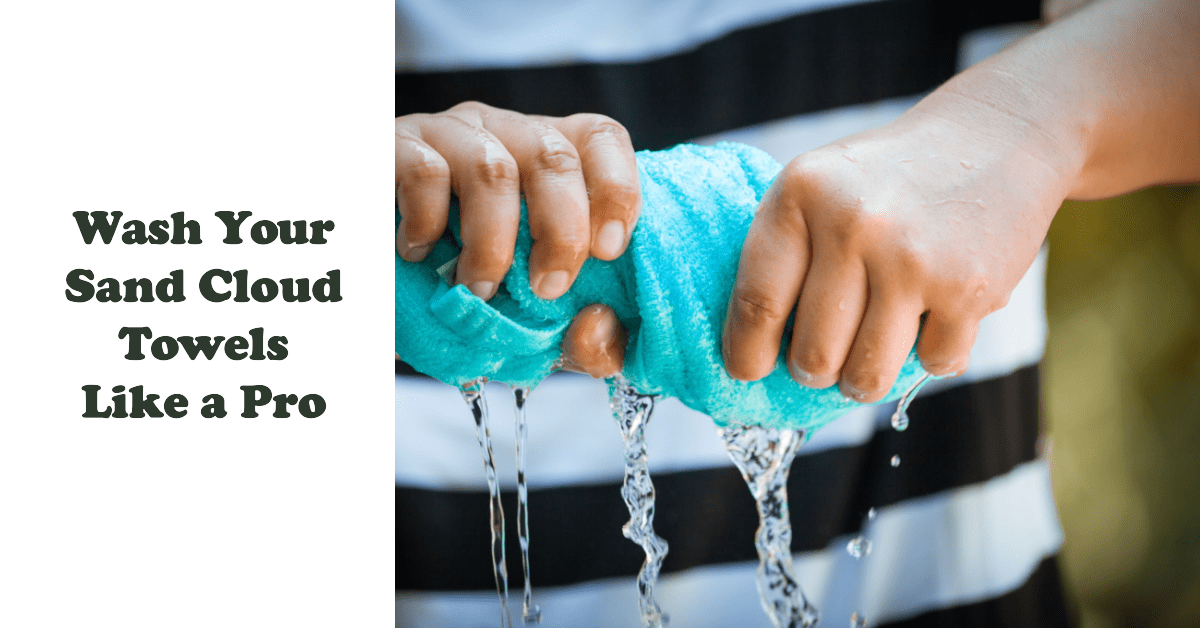Caring for your towels isn’t just about keeping them clean; it’s about making sure they stay soft, colorful, and absorbent.
In this guide, we’ll explore how to wash both new and old Sand Cloud towels. We’ll give you simple, step-by-step instructions and useful tips to ensure your towels last a long time.
Why Proper Washing Matters
Sand Cloud towels are made with premium materials for ultimate comfort and functionality. Washing them properly ensures that these qualities stay intact, which helps extend the lifespan of your towels. Taking good care of them also keeps the colors bright, stops them from fading, and keeps them looking nice.
General Towel Washing Guidelines
According to Sand Cloud’s official guidelines, use these simple washing tips for the best results:
- Machine Wash Cold: Use a delicate cycle to protect the fibers.
- Avoid Heavy Garments: Do not wash with jeans or heavy-weight items.
- Separate Tie Dye Towels: Prevent bleeding by washing tie dye towels separately.
Washing New Sand Cloud Towels
Preparing for the First Wash
New towels may have residual manufacturing substances, so it’s advisable to wash them before use. Follow these steps:
- Carefully check the tag for any special washing instructions.
- Wash new towels separately from other laundry to prevent any potential bleeding of excess dye.
- Give the towels a good shake to remove loose fibers or debris.
Machine Washing and Air Drying

Follow these steps to ensure a proper first wash for your new towels:
- Load the Washer: Place the towels in the washing machine, ensuring they have enough space to move freely.
- Use Cold Water and Delicate Cycle: Set the machine to cold water and the delicate cycle for a gentle wash.
- Avoid Fabric Softeners: Skip fabric softeners as they can reduce towel absorbency.
- Air Dry in Shade: For best results, hang the towels to air dry in the shade.
Tips to Prevent Bleeding for Tie Dye Towels
- Wash Separately: Always wash tie dye towels separately from other items to prevent bleeding.
- Monitor First Few Washes: Pay close attention when you first wash the towels, and don’t mix tie-dye towels with lighter-colored clothes.
Washing Old Sand Cloud Towels
Older towels may require additional care to revive their softness and absorbency:
- Inspect for Stains: Check for any stains or discoloration that may need pre-treatment.
- Pre-treat Stains: Treat any stains with a mild stain remover before washing.
Dealing with Stains or Discoloration
- Use Gentle Detergent: Opt for a mild detergent to avoid further damage to the fabric.
- Pre-treat Stains: Apply a small amount of stain remover directly to the affected areas.
- Loading Towels: Place the towels loosely in the machine, avoiding overcrowding for a more effective wash.
- Machine Wash on Delicate Cycle: Use a delicate cycle to minimize stress on the older towel fibers.
- Air Dry for Best Results: To maintain softness, air-dry the towels in the shade.
Additional Care Tips for Maintaining Quality
- Avoid Fabric Softeners: Fabric softeners can reduce the absorbency of towels, so it’s best to avoid them.
- Proper Storage: Store towels in a dry, well-ventilated space to prevent mildew.
Drying Techniques
While air-drying is the preferred method, there are instances where tumble drying may be necessary:
- Air Drying: Hang towels in a shaded area to air dry naturally, preserving their softness.
- Tumble Drying: If time is a constraint, tumble dry on a low heat setting to fluff up the towels.

Troubleshooting Common Issues
If you encounter problems such as bleeding or stiffness, here are some troubleshooting tips:
- For Bleeding Issues: If bleeding occurs, rewashing tie dye towels separately should minimize the problem.
- For Stiffness: Add a small amount of white vinegar to the rinse cycle to restore softness.
Tips for Restoring Softness and Absorbency
- White Vinegar Rinse: Add half a cup of white vinegar to the rinse cycle to restore softness.
- Avoid Excess Detergent: Overusing detergent can leave residues, affecting absorbency.
- Avoid Harsh Chemicals: These can reduce absorbency and affect material integrity.
- Proper Storage: Store towels in a well-ventilated area to prevent mildew and maintain freshness.
How Often Should You Wash Sand Cloud Towels?
The frequency of washing depends on usage and personal preference. As a general guideline, washing towels every three to four uses helps maintain hygiene without unnecessary wear.
Conclusion
Taking good care of your Sand Cloud towels is like making a smart investment in their long-lasting quality and performance. Whether you have new towels that need gentle care or older ones requiring special attention, following these guidelines will ensure your towels remain soft, vibrant, and functional for years to come.
Additional Resources
For detailed washing instructions and recommended products, refer to Sand Cloud’s official guidelines.
Frequently Asked Questions
Are Sand Cloud towels machine washable?
Yes, absolutely! Sand Cloud towels are machine washable. To maintain their quality, we recommend washing them in cold water with similar colors. Avoid using bleach or fabric softeners as they may harm the fabric. Tumble dry on low heat or air dry for the best results. It’s that simple!
Can I use fabric softeners when washing Sand Cloud towels?
It’s best to skip the fabric softeners when washing your Sand Cloud towels. These towels are designed to maintain their softness naturally, and fabric softeners may hinder their absorbency over time. Stick to a simple wash routine for the best results.
Is it necessary to air dry Sand Cloud towels, or can I use a dryer?
While you can use a dryer, we recommend air drying your Sand Cloud towels for optimal longevity. If you prefer using a dryer, set it on low heat to prevent any potential damage. Air drying, however, allows the towels to maintain their softness and absorbency for a longer period.

